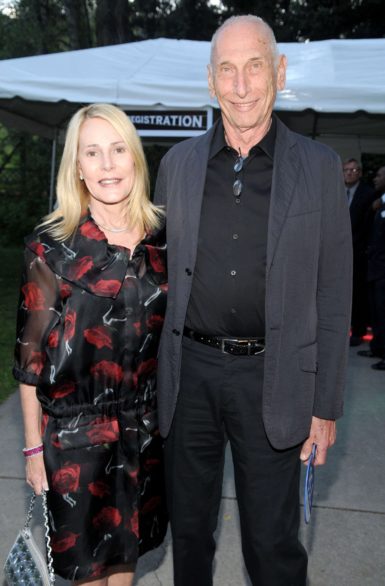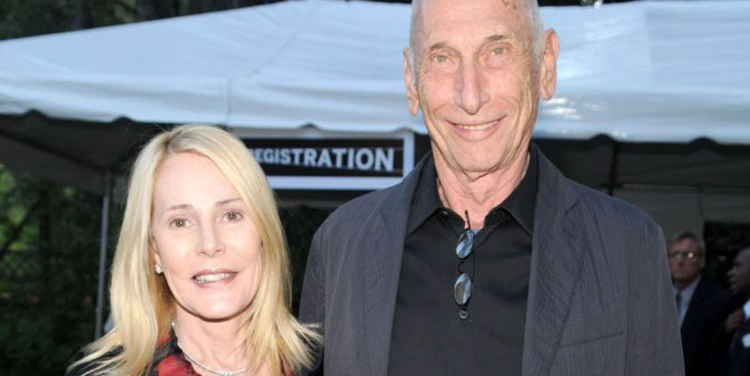[ad_1]

Gael Neeson and Stefan T. Edlis.
SIPA/SHUTTERSTOCK
Stefan T. Edlis, the colossal Chicago-based collector who plowed a fortune he made in plastics into postwar and contemporary art, has died. He was 94. The news was first reported by the Chicago Sun Times.
Long known for a premier collection of Pop art that he built with his wife, Gael Neeson, Edlis made a star turn in a recent HBO documentary about the art market, providing one of the film’s most poignant moments. In an interview at their home, with a Robert Rauschenberg hanging behind him, Edlis paraphrased Oscar Wilde, telling filmmaker Nathaniel Kahn, “There are a lot of people who know the price of everything and the value of nothing.” In a dizzying age when auction records climb higher and higher—and the attention to them becomes even more frenetic—it was a succinct summation of the art industry today. And it gave Kahn the title to his documentary, The Price of Everything.
Also seen in their home, among a bevy of valuable works, were a “Gazing Ball” sculpture by Jeff Koons, a Liz Taylor silkscreen by Andy Warhol, and a Richard Prince “Yes, Rasta” work. The couple, who has appeared on the ARTnews Top 200 Collectors list each year since 1993, still maintained a major store of choice artworks even after donating 44 pieces, valued at more than $500 million, to their hometown museum, the Art Institute of Chicago, in 2015. Included in that gift were nine pieces by Andy Warhol, three by Jasper Johns, four by Gerhard Richter, two by Roy Lichtenstein, and a combine by Rauschenberg, as well as six photos by Cindy Sherman and seven by Richard Prince.
At the time of the gift, the Art Institute’s director, James Rondeau, told the Chicago Tribune that Edlis and Neeson “did not buy based upon opportunity. They did not buy based upon what was offered to them. They did not buy dictated by the fashions of the marketplace. They waited until they had the opportunity to acquire the most iconic, most significant (work) in terms of provenance, in terms of condition, in terms of its place in an artist’s career.”
Stefan T. Edlis was born in Vienna where he lived until the age of 15 when he escaped in 1941, fleeing the Nazis. He and his family settled in New York. Two years later he was drafted into the war efforts and served in the Navy.
After the war, Edlis moved to San Francisco, which had a bustling plastics industry and by 1965 he had founded the Apollo Plastics Corporation in Chicago, which made him a fortune.
It was in the mid-1960s that he took an interest in art, first buying works made in plastic. But it wasn’t until the 1970s, after he had met and married Neeson, that he started on his way to becoming a serious collector. Among his first big purchases was a Mondrian painting for $675,000—a bargain price by today’s standards but a big sum then.
“Everyone wanted to know who overpaid for this Mondrian,” Edlis told Crain’s Chicago Business in 2015. “They made pilgrimages to meet me.”
Though a work of high modernism was their first major purchase, Edlis and Neeson would become known for their deep commitment to art after Abstract Expressionism. Among the artists they collected where the groundbreaking iconoclasts Jasper Johns and Robert Rauschenberg, the masters of Pop Art from Andy Warhol to Roy Lichtenstein, and contemporary figures like Jeff Koons, Damien Hirst, Charles Ray, Maurizio Cattelan, and Katharina Fritsch.
The couple set strict parameters for their collecting. They would only ever own 200 works, by no more than 40 artists—the perfect amount to install between their two homes in Chicago and Aspen, Colorado. That meant that new purchases sometimes required tough choices.
Among the works that left the collection over the years were Warhol’s Turquoise Marilyn, which they sold to fellow Top 200 Collector Steven A. Cohen for $80 million in 2007, and Lichtenstein’s The Ring (Engagement), which went for $41.7 million at Sotheby’s New York in 2015.
“There are thousands of good artists,” Edlis said in the 2015 Crain’s interview. “If you try to understand more than what you can get through your head, you won’t give them the proper attention.”
The couple was heavily involved in philanthropy pursuits—they gave a $10 million gift to the Museum of Contemporary Art Chicago, and donated to that institution Jeff Koons’s 1986 Rabbit, for which they paid $945,000 in 1991. (Another cast of that Koons sculpture sold at Sotheby’s New York this past May for $91.1 million, the largest sum ever paid for work by a living artist. The MCA values its Koons Rabbit at $100 million.)
But it was their 2015 gift to the Art Institute, where Edlis had served on the board, that truly turned heads, particularly because of the stipulations that came with the gift. The works are to be shown together in prime real estate in the museum for 25 years and then throughout the museum for the next 25 years.
Edlis, it seemed, wanted the museum to follow the couple’s own protocols when displaying the art from their storied collection. He told Crain’s, “My beef has always been, ‘Why should I give it to you if you’re going to show it for eight weeks and then put it in storage?’”
[ad_2]
Source link

